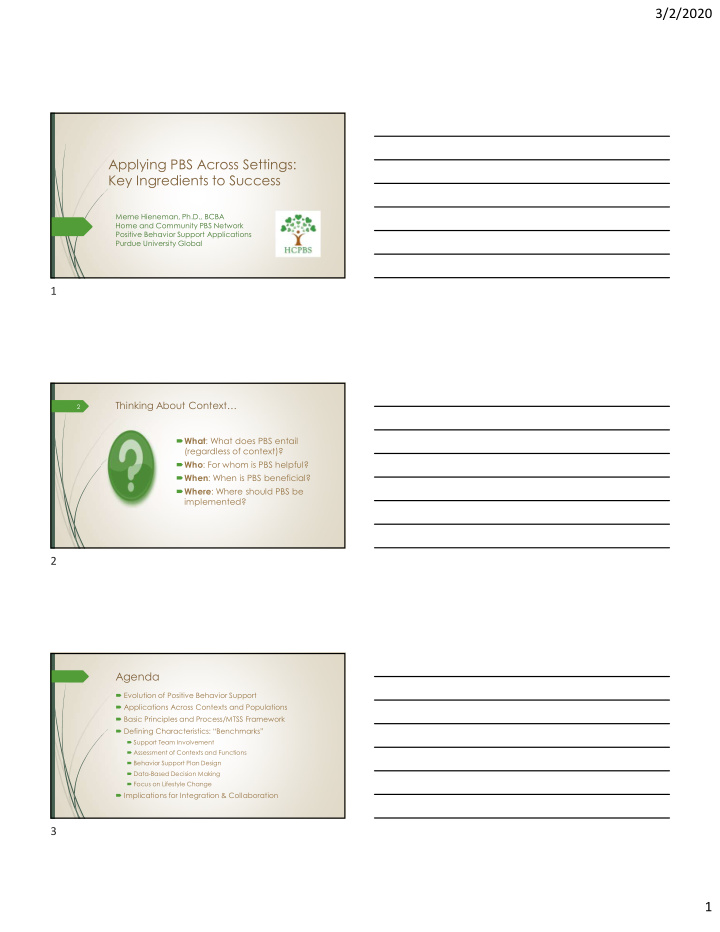



3/2/2020 Applying PBS Across Settings: Key Ingredients to Success Meme Hieneman, Ph.D., BCBA Home and Community PBS Network Positive Behavior Support Applications Purdue University Global 1 Thinking About Context… 2 What : What does PBS entail (regardless of context)? Who : For whom is PBS helpful? When : When is PBS beneficial? Where : Where should PBS be implemented? 2 Agenda Evolution of Positive Behavior Support Applications Across Contexts and Populations Basic Principles and Process/MTSS Framework Defining Characteristics: “Benchmarks” Support Team Involvement Assessment of Contexts and Functions Behavior Support Plan Design Data-Based Decision Making Focus on Lifestyle Change Implications for Integration & Collaboration 3 1
3/2/2020 APBS Definition of PBS Positive Behavior Support (PBS) is a set of research- based strategies used to increase quality of life and decrease problem behavior by teaching new skills and making changes in a person's environment. Positive behavior support combines: Valued outcomes; Behavioral and biomedical science; Validated procedures; and Systems change to enhance quality of life and reduce problem behaviors. 4 Characteristics of PBS (Kincaid, Dunlap, Kern, et al. 2016) Research-based assessment, intervention, and data-based decision making Building social and other functional competencies, creating supportive contexts, and preventing the occurrence of problem behaviors Respectful of a person’s dignity and overall well-being Based on behavioral, educational, and social sciences, although other evidence-based procedures may be incorporated. 5 PBS as a Multi-Tiered Approach Individua l Targeted Group System/Universal Duchnowski & Kutash, 2009; Fox & Hemneter, 2009; McCart et al., 2009; Sugai & Horner, 2009 6 2
3/2/2020 Evolving Practices in ABA/PBS Systems Application Integrated (using PBS to Intervention improve schools and agencies, as (combining Functional methods based on well as enhance other programs) Analysis FBA: - prevention (identifying - teaching purposes of - management) Systematic behavior to Instruction determine intervention) (chaining, shaping, error correction) Applying Carr et al., 2002; Dunlap et al., 2008; Principles Dunlap, Sailor, Horner, & Sugai, 2009; (reinforcement Lucyshyn, Dunlap, & Freeman, 2014: contingencies) Snell, 2005 7 Application Across Disciplines and Populations Schools/ Educational Systems Early Intervention Families/ Homes Positive Behavior Mental Support Health Aging Developmental Juvenile Disabilities Justice Child (I/DD, Autism) Welfare 8 Necessary Components of PBS Collaborative Process Assessment of Contexts & Functions Multicomponent Behavior Plans Data Based Decision Making Focus on Lifestyle Change Assessment of PBS Practices Questionnaire www.flapbs.net: Resources, Practice, Community 9 3
3/2/2020 Features Identified in Selected Seminal Works Sources Collabor- Assessment Multi- Data-Based Focus on ative of Contexts component Decision Lifestyle Process & Functions Plans Making Change Horner, Dunlap, Koegel et X X X X al. (1990) Articles/Guides Dunlap, Hieneman, Knoster X X X X X et al. (2000) Carr, Dunlap, Horner et al. X X X X X (2002) Anderson, Brown, Scheuer- X X X X X mann et al. (2007) Koegel, Koegel, & Dunlap X X X X X Edited Books (2006) Sailor Dunlap, Sugai, & X X X X X Horner (2009) Brown, Anderson, & De Pry X X X X X (2015) 10 Collaborative Process Stakeholders from all relevant settings Person-centered/group action planning Team involved in all aspects of process Information and training provided Communicate consistently 11 Assessment of Contexts and Functions Assessments include: Interviews/indirect assessments Direct observations across contexts Ecological/curricular assessments Assessments result in patterns: Probable functions of behavior Circumstances that trigger behavior 12 4
3/2/2020 Assessing Contexts and Functions Behaviors of Maintaining Setting Events Antecedents Concern (Conditions or Consequences (Specific Triggers) Circumstances) (Get/Avoid) Positive When Problematic Where With Whom What Activities 13 Behavior Support Plan Design Interventions linked to patterns Behavior support plans include: Goals and specific behaviors of concern Environmental arrangements to support behavior Instructional targets and teaching strategies Management of consequences (R+) Maximize autonomy and respect 14 Behavior Support Plan Elements Antecedent/ Maintaining Behavior Consequences Setting Events Proactive Strategies Teaching Strategies Management Strategies Changing environment to Teaching skills to replace Responding to behavior prompt positive behavior and problem behavior or to reinforce positive and make problem behavior allow individuals to be not negative behavior unnecessary (prior to the more successful behavior) Modifying setting events to improve lifestyle and climate Supporting caregivers and practitioners to implement interventions consistently 15 5
3/2/2020 Data Based Decision Making Behaviors of concern defined objectively Objective data collected to monitor progress and evaluate outcomes Implementation monitored to ensure fidelity Data synthesized and analyzed to guide decision-making 16 Focus on Lifestyle/System Change Achievement of meaningful goals(e.g., participation, relationships) Intervention strategies are designed to be implemented by caregivers fit within natural routines Advocacy for resources/systems change as needed 17 Domains of Quality of Life Health and Productive Community Safety Activity Participation Self- Social Advocacy & Relationships Choice PBS Quality of Life Questionnaire 18 6
3/2/2020 Contextual Fit Systems Caregivers Settings Individual 19 Implementing PBS at a Systems Level Leadership and Planning Processes Hiring Practices and Job Descriptions Supportive Policies and Procedures Resources and Universal Supports Templates, Tools, and Resources Training and On-Site Coaching Evaluations and Incentive Systems Data Collection Tools/Systems 20 Implications for Practice Jargon- Free Zone Clarity and consistency in defining PBS Engaging and empowering stakeholders Blending with other disciplines – and integrating in existing processes - without losing integrity Creating sustainable training and implementation tools and ensuring fidelity Ensuring shared goals and coordinated activity Attending to contextual fit and diversity in all aspects of our work(e.g., goals, measures, interventions) 21 7
Recommend
More recommend